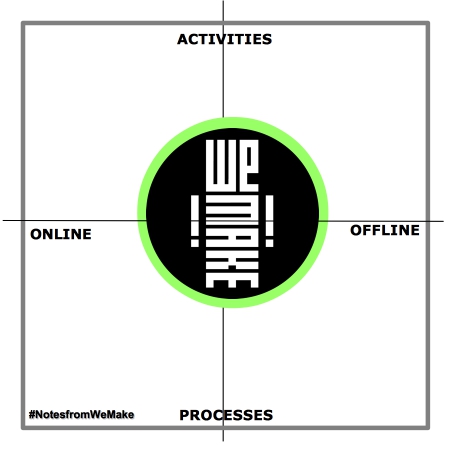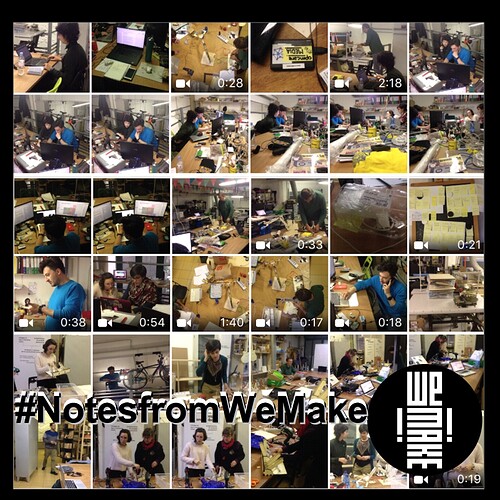Answering Noemi’s questions…
My research set now consists in understanding how daily practices are enacted (the “shop floor problem” for instance) and what forms of collaboration take place, where and when.
The criteria i’m using are visible in this simple schema, useful for me to assign each WeMake practice to a specific sector (ONLINE/OFFLINE/ACTIVITY/PROCESS) and making life easier, at least at the beginning.

My big surprise is that processes are negotiated within activities (so the boundary between “how” and “what” are very… blurry let’s say), and that most of the work (activities mostly) is strongly CSCW style and run online and in a synchronous way (WeMake staff uses instant messaging -SLACK- and task assignment and management tools ASANA instead of blogging style communication). When there are misunderstandings and reverse salients a videocall or a meeting is organized, but meetings are also planned and scheduled.
The work around opencare (i’m following openrampette now) is organised in a “exquisitely” collaborative way and includes external inputs from the Municipality of Milan, users and further collaborators. Moreover, people of WeMake work often remotely from home (Alessandro for instance lives in Turin). Here, at WeMake, i could already glimpse collective intelligence practices, given the fact that any result (a post, a activity, a decision, a design object, …lunch) is a catch up of a collective and negotiated effort. Doubts and uncertainty are put daily on the table and each of the members of WeMake staff can give his own advice, or strategic tip, but solutions are collectively made. WeMake works and happens by and in a WeKnow mind set.
So, the first conclusion is that at WeMake, people don’t work offline, but in a different way to what we have seen so far on https://edgeryders.eu/en/opencare-research
All this can might implemented in some ways to Ezio’s matrix given that it happens the other way round  …from activities and collaborations (in Milan and online) to events (my posts), but further discussion is needed.
…from activities and collaborations (in Milan and online) to events (my posts), but further discussion is needed.
Last, but not least, the approach consists in describing by different “senses” what happens at WeMake. I’m recording mp3 audiofiles (soundscapes, conversations, interviews), taking pictures and shooting videos, and -of course- taking notes.
I’m also working on the side of self representation by WeMake people and on how what is social and what is technical co-emerge and objects, relations and identities are classified (this is a social problem, this a technical one…for instance). All this is terribly interesting and useful.


